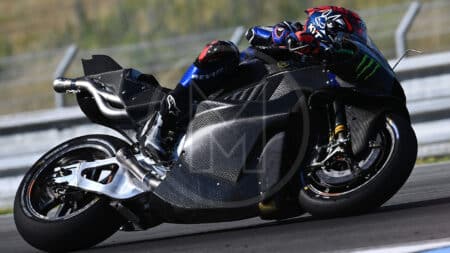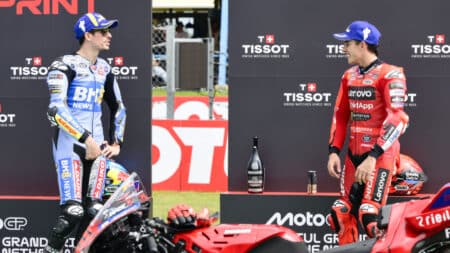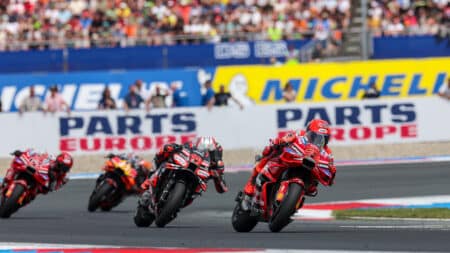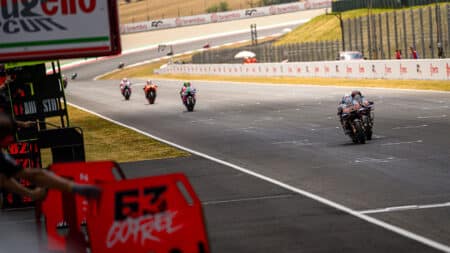
Exclusive: Yamaha’s V4 MotoGP bike seen for the first time!
After months of waiting, we’ve managed to get the first photos of Yamaha’s all-new MotoGP bike, designed to revive the factory’s fortunes in MotoGP
Pedrosa’s MotoGP career may have been blessed with the HRC golden ticket, but racing, regulations and broken bones have (mostly) conspired against him

Dani Pedrosa was once king of the Sachsenring. He won the 250 race in 2004 and 2005, then a hat-trick of MotoGP victories in 2010, 2011 and 2012, before Marc Márquez came along.
But that’s another story. Today we are talking about Pedrosa, MotoGP’s pint-sized perennial performer who, last Thursday, announced his retirement.
Pedrosa has broken a few records and many more bones during a long career during which he’s never quite lifted the MotoGP crown. But if you think he’s just been unlucky, you don’t know the half of it.
The 32-year-old is the only rider in 70 years of Grand Prix racing to have won at least one race a year over 16 consecutive seasons. That’s quite a record, achieved on non-factory Honda RS125s and RS250s and on factory RCVs. And no other Honda rider has won more races. He’s currently on 54 wins, which puts him equal with ‘Mighty’ Mick Doohan and well ahead of Honda’s other greatest performer, Jim Redman, who won 45 GPs during the 1960s, when riders were lucky to survive 45 races, let alone win them.
So what makes Pedrosa remarkable, apart from the fact that he’s won more premier-class races than Kevin Schwantz and ridden a factory Honda for 13 seasons without winning the title? It’s so obvious that it’s a cliché: the man is tiny, more like a schoolboy than a big, bad bike racer.
Pain has been his constant bedfellow for years…
The little samurai won the 125 crown in 2003 and the 250 title over the next two years. He is one of the all-time greatest 250 riders: small, light, glass-smooth and inch-perfect.
Then he was promoted to MotoGP. During his premier-class career he has won 31 races and finished championship runner-up on three occasions; making him the sport’s most successful failure, inheriting that unwelcome mantle from that other so-near-but-so-far hero Randy Mamola.
People who criticise him for his failures don’t understand how his gilded path to the pinnacle of racing has been steep and serpentine, strewn with rocky hairpins and precipices.
Pedrosa stands at five foot two inches tall (160 centimetres) and weighs eight stone (51 kilograms). That’s the size of an average or 13/14-year-old boy. You might say that he’s been a boy trying to make his way in a man’s world since April 2006.
His size has been a huge handicap and continues to be. Indeed everything seems to have conspired against him, despite that glittering Repsol Honda golden ticket.
In 2007 MotoGP switched from 990cc engines to 800cc engines, because Dorna and the FIM had decided that the 990s were too fast, following Daijiro Kato’s fatal crash.
This should have been Pedrosa’s moment. HRC tailormade its 800cc RC212V to suit its new hero. But it was the Spaniard’s misfortune that this was HRC’s lowest ebb as a MotoGP manufacturer. Honda’s RC211V was an all-time great GP bike and the current RC213V is very fast, in the right hands. But the RC212V was mostly a disaster. Pedrosa spent what was arguably his best years fighting with the 212.
“Even the beginning of 2010 was a nightmare – the bike wouldn’t even go straight on the straights,” he told me a few years ago.
Then just as HRC got the RC212V consistently competitive, the injuries kicked in. In October 2010, Pedrosa was hauling in title-leader Jorge Lorenzo when he was thrown off by a jammed throttle, breaking a collarbone.
The following year he was again catching Lorenzo when he collided with Marco Simoncelli, breaking another collarbone. In 2012 he was in the middle of a storming run of victories and homing in on the title lead once more when he was taken out at Misano. In 2013 he crashed at 40mph during German GP practice and broke another collarbone. Pain has been his constant bedfellow for years: collarbones, wrists, knees, arms, fingers, feet, a tibia, a fibula and much, much more.
All these injuries aren’t the result of brittle bones, they’re caused by a featherweight physique that prevents him from riding that bucking bronco when things go wrong. “There’s no doubt why he’s broken his body so much, even with little crashes,” explains former Honda MotoGP rider Jack Miller. “Whenever he has a crash the bike always flicks him into the air because the bike’s so much bigger than him. It’s like when he got highsided in Argentina this year, or anywhere else.”

Whenever Pedrosa challenged for the title things went wrong and since then they’ve got worse. The global economic meltdown of 2008 had a big effect on MotoGP, with new cost-reduction regulations introduced each year, all of them conspiring against the atypical rider. For example, between 2008 and 2011 minimum machine weight increased from 148kg to 157kg; a big difference for a man the size of a boy.
Miller is one of many MotoGP riders who is certain Pedrosa would’ve won the MotoGP title at least once if he was more of a match for the machinery.
“The rest of us can manage these beasts more easily,” adds the Australian. “We’ve got more weight over the top of the bike, we’ve got more strength and more leverage with our longer arms and legs. Dani is short, so he’s got short arms, short legs, small hands and small feet. Even for us, it’s a lot of hard work to try and muscle a big piece of machinery around.”
In 2009 control tyres were introduced, all of them designed for riders of a median weight, between 65kg and 70kg; about 25 per cent heavier than Pedrosa. No wonder he struggled to get heat into tyres, often with agonising consequences.
In 2016 MotoGP switched from Bridgestone to Michelin. Many paddock people presumed the softer construction of the French tyres would work in his favour, but, in fact, things once again got worse for him.
“When Michelin first started testing with us, I was always the fastest and I always felt okay with the tyres, while everybody else was crashing and wasn’t comfortable with the tyres,” he says. “I had no complaints but in the end the majority must choose. The tyres felt good to me, but they felt too soft for the bigger guys. And because there are many more big guys than small guys, they said these tyres are too soft, so the soft tyres were taken away and the harder tyres arrived…”
His problems were magnified even more when unified electronics arrived in 2016. All of the software is written for riders of an average size and a certain riding technique, so once again Pedrosa found himself out of the loop.
So now the bikes were too heavy, the tyres too hard and the electronics not quite right. No wonder his results went from often good to mostly bad.
There’s probably no one better to discuss Pedrosa’s predicament than a suspension engineer. Mats Larsson has been at Öhlins for more than three decades, so he knows Pedrosa very well.
“The challenge for Dani is that he’s tiny,” affirms Larsson. “You have normal-sized riders like Miller or Franco Morbidelli who can move around the bike, so they can change how the bike works, how the bike turns, how the bike grips into corners and out of corners. In MotoGP people talk about moving the preload or the ride-height by half a millimetre, but what happens when the rider moves 10 millimetres on the bike? That changes the whole dynamics of the machine much more than making a half-millimetre adjustment. Other riders move around and hang off, but Dani can’t do that, simple as that. His big challenge has always been to have a set-up that allows him to get some positive weight transfer between the front and rear tyres, because he can’t really do this himself.”
No other rider uses a suspension set-up like Pedrosa, because they don’t need to and they certainly wouldn’t want to. While most riders use a rear spring of between 85 and 90 Newtons, Pedrosa uses a 77N spring. That’s a huge difference and illustrates just how difficult it is for the Spaniard to get enough load into the rear tyre to generate heat and grip.
“You need to have a certain load to get the temperature into the tyres and this isn’t easy for Dani,” adds Larsson. “Also, he can’t muscle the bike around like the others. He is therefore very picky about the balance of the bike: how it reacts when he’s accelerating, whether it’s squatting and so on, because he can’t compensate if the bike isn’t perfect, unlike Marc [Márquez] who is all over the bike. It’s a big challenge for us to please him. He is very light, so he’s very sensitive to any changes – he needs fewer clicks than the others to understand a good direction.
“Dani’s hands are like a child’s hands, so things like handlebar position and so on are also very critical for him. We try to get him as far forward as we can, so he can manoeuvre a little with the handlebars, because he can’t really move back. Really, he looks like someone riding a 1972 Ducati 900SS: with the clip-ons way up front and the seat way back!”

In other words, Pedrosa is a ferret strapped to a rocket. The late, great Angel Nieto said that “Dani rides like an angel”, although only because he has no other choice.
He cannot manhandle his machine, so his style is seamless, with each movement segueing into the next. He has to ride ahead of himself, with each phase planned in advance, because he cannot make last-moment adjustments, which is why he’s not so great in elbow-to-elbow battles.
Pedrosa was the first rider who became an expert at picking up the bike on the exit of corners, to use the fatter part of the tyre. He developed this technique because that’s the only way he can find enough traction to open the throttle. This gave him an advantage for some years, until everyone copied him. And in recent years, when the fastest riders have hung off more and more to improve turning, he’s been left further behind.
Larsson again: “Dani picks up the bike up because he has to – because he’s so small. He’s very clever about this and he’s very good at using the chain force when he gets on the throttle to help him find traction. The problem comes when he is involved in a dogfight, because he cannot wrestle the bike like the other guys.
“The unified electronics were another bad thing for Dani. Honda had very good electronics strategies, very refined. But, with the new electronics, the bikes became more wild and more snappy, with more pumping from the suspension, so this was more of a problem for him than for the other guys.”
Pedrosa has suffered a lot of criticism for his failure to win a MotoGP world title, but his career has been an uphill struggle.

After months of waiting, we’ve managed to get the first photos of Yamaha’s all-new MotoGP bike, designed to revive the factory’s fortunes in MotoGP

Alex Márquez has finished runner-up to older brother Marc in 13 of 20 MotoGP race starts this season and after last weekend's Dutch TT Grand Prix it seems some impatience is brewing with the sibling dynamic

Marc Márquez woke up on Sunday morning unsure he could race, following two big crashes in practice for the 2025 Dutch Grand Prix. And yet he continued to steamroll his MotoGP rivals and the record books

Mugello has been the home of Rossi mania and lately a fortress for Ducati… but the Italian circuit is chiefly synonymous for the biggest rush in MotoGP racing